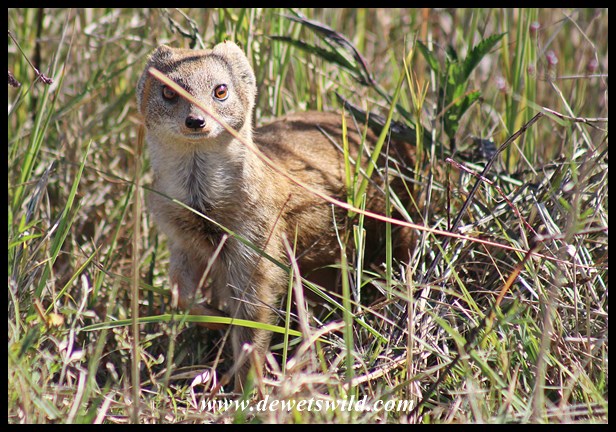Cynictis penicillata
The lithe little Yellow Mongoose can grow to lengths of up to 75cm, and adults weigh from 440 to 900g. They inhabit a wide variety of open habitats, from semi-desert scrub to grasslands and savannas. They are independent of drinking water, and feed mainly on insects, other invertebrates, rodents, small birds and reptiles and frogs, and occasionally carrion and fruit. They have been known to raid chicken runs.
Yellow Mongooses are diurnal and live in colonies that number from 5 to 50, lead by a dominant breeding pair. Within their home ranges, colonies usually have several extensive burrow systems that they normally dig themselves, but often share with meerkats and ground squirrels. They usually forage alone and when threatened while out foraging they will hide in any available thicket or hole.
Litters of 1 to 5 pups are usually born in the summer, and while it is usually only the dominant pair that breeds, all group members assist with the care of the babies. Yellow Mongooses’ main predators are raptors and jackals, while snakes and monitor lizards will take babies from the burrows. Yellow Mongooses are notorious carriers of rabies. They have a natural life expectancy of about 12 years.
Yellow Mongooses occur in Namibia, Botswana, South Africa and marginally into adjacent areas of Angola and Zimbabwe. They occur all over South Africa, with the exception of the Lowveld of Mpumalanga and Limpopo and the coastal plain of Kwazulu-Natal. The IUCN lists the species as being of least concern.






























Nice mongoose photos, they have plenty them in the wild on Oahu
LikeLike
I think mongooses may be one of the world’s most widely distributed kinds of mammals. Welcome here!
LikeLike
They are just adorable I alwYs tease my Bellarina that she looks like one always dancing on back feet lol great pictures always love when so get time to lose myself in your great adventures THANKYOU …ELLE
LikeLiked by 1 person
These little guys are so inquisitive, and seem to be always on the go!
LikeLike
Skatlike diertjie met sy wakker ogies.Pragtige foto’s, Dries!
LikeLiked by 1 person
Baie dankie, Dina!
LikeLiked by 1 person
Hi guys.Great photos. The mongoose crossing the road reminds me of a small dog – very alert and intellligent looking!
LikeLiked by 1 person
Thank you, Kim!
LikeLiked by 1 person
How cute are they!
LikeLiked by 1 person
Very, especially when they’re standing up straight!
LikeLiked by 1 person
😀😀
LikeLike
Going to SA soon, we will definitely be on the lookout for these guys! Thanks for publishing your great shots and all the info about them, very interesting to read 😃
LikeLiked by 1 person
I’m sure you are very excited about your upcoming visit – looking forward to hearing your impressions of our beautiful country!
LikeLiked by 1 person
Sweet! We both love your country and have been there several times. This time will be for our website 🙂
LikeLiked by 1 person
Another beautiful animal I never seen before. 🙂 It reminds of a meerkat when it stands up. maybe relatives?
LikeLiked by 1 person
Indeed John – the meerkat is probably our best known species of mongoose.
LikeLiked by 1 person
It seems like mongooses always seem to have a part of many types of related animals that look like them…
LikeLiked by 1 person
They do have qualities of both the cat and dog family, don’t they Cayenne?
LikeLiked by 1 person
It sure looks like it!
LikeLiked by 1 person
fascinating, they seem to be closely related to meerkats in behaviour and activity. Is there a link?
LikeLiked by 2 people
Indeed Julie – the meerkat (or suricate) is probably our best known species of mongoose.
LikeLike
Arrhh i never knew that
LikeLiked by 1 person
Fascinating, de Wets. Great shots and information.
LikeLiked by 1 person
Thanks a lot, Jane!
LikeLike
Cute little guys! 🙂
LikeLiked by 1 person
To everyone except chickens!
LikeLiked by 1 person